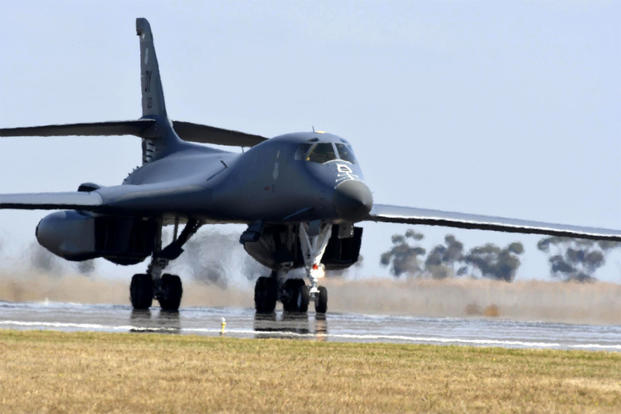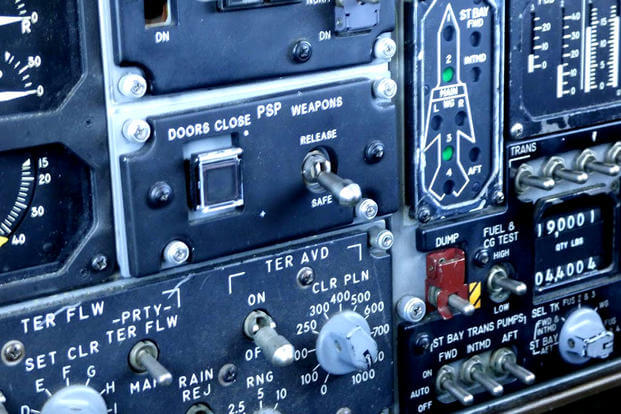DYESS AIR FORCE BASE, Texas -- If there had ever been a "nuclear button," this would have been it.
A switch on the B-1B Lancer's dashboard labeled "weapons" toggles between "release" and "safe."
Maj. Charles "Astro" Kilchrist, chief of training for the 9th Bomb Squadron and a B-1 pilot, pointed it out during Military.com's flight in the B-1B over training ranges in New Mexico on Dec. 19.
The switch, now used in the process to release both guided and unguided conventional bombs, once could have launched nuclear weapons before the B-1 fleet was converted to a non-nuclear role.
Related content:
- Anatomy of a B-1 Bomber Training Mission
- What's on a B-1B Lancer Aircrew's Wish List? Room for More Bombs
- B-1 Bomber Crews Defend Sniper Pod After Friendly Fire Incident
The B-1, which has the largest payload in the bomber fleet, can be put into any theater without stirring the same concerns as nuclear-capable aircraft, Kilchrist said.
"We have the ability to have a global footprint," he said.
Recently, the B-52 Stratofortress replaced the B-1B in the Pacific. The move marked a significant shift to bring back the B-52H -- which provided a continuous bomber presence in the region from 2006 to 2016 -- to put a nuclear-capable bomber in theater at a time when relations between the U.S. and North Korea are largely unpredictable.
The B-1, by comparison, is all about variety now -- the missions it can perform, and the bombs it can drop, Kilchrist said.
"The list of weapons [we have now], it's pages and pages of different options and different systems," added Lt. Col. Christopher Wachter, director of operations for the 345th Bomb Squadron at Dyess. "The mission sets [have] grown."
And Kilchrist has an answer for critics who say the supersonic-capable bomber should be converted back: "It's not an easy disconnect," he said, adding, "Why add that one more [detail] in a conventional bomber now?"
Treaty Compliance
The B-1 fleet was converted as part of the Strategic Arms Reduction Treaty.
Every year, Russian officials travel to either Ellsworth Air Force Base, South Dakota, or Dyess to review whether the B-1 fleet complies with the treaty, which specifies it must remain disarmed.
"It's fine … it's nothing contentious," said Col. Brandon Parker, 7th Bomb Wing commander, during a roundtable discussion Dec. 18. "We fully support compliance with the treaty. It's part of the inspection regime. We see it as a part of our mission."
Compliance with the treaty ended the bombers' nuclear future, so many were surprised when the fleet was realigned in 2015 from Air Combat Command to Global Strike Command, which oversees strategic nuclear deterrence.
"We liked it better that way [under ACC]," said Lt. Col. Dominic "Beaver" Ross, director of operations for the 337th Test and Evaluations Squadron. Ross still wears an ACC patch on his flight suit because the testing and evaluations portion of the mission resides with the 53rd Wing under ACC.
For the testing office, there's been some jumble, he said.
For example, "We have noticed, when you combined us with the B-52, as far as testing and stuff goes, they almost drudge us down a little bit; it kind of diluted the pool, if you will, when you take the two and combine the program office [into one]," Ross said.
"That's still a hurdle we're trying to overcome, because you're spreading what we had available to us out over more, so we get a little bit less [in both money and resources]," he said.
He added, "It's a weird realm because we have to operate under both sets of regulations in [the Air Force Instruction]. We think of them differently too. They're [The B-52s] more high-altitude; they're the nuke guys. We're two completely different animals."
Still as an ops director, Ross knows both the B-52 and B-1 communities are proud of their work.
For the B-1s, "we try to keep it the most lethal machine there is," he said.
Prepping for the B-21
B-1 operators are keeping in mind how they may shift again in preparation for the B-21 Long Range Strike Bomber -- the Pentagon's latest classified, multi-billion-dollar program in development by Northrop Grumman Corp. -- should it come to Dyess.
Officials are weighing whether the B-21 should eventually replace a portion of the B-1 fleet, since it will have both nuclear and non-nuclear roles.
The first B-21s are expected to reach initial operating capability in the mid-2020s.
"We try to posture ourselves as best we can so that if the [B-21 Raider] does come here, leaders, our senior leaders make that decision to bring it here, that we're ready," Parker said.
"But until it comes, we're going to fly these B-1s … full speed ahead. We're an afterburner, and we're going to go as full speed ahead as best we can," he said.
-- Oriana Pawlyk can be reached at oriana.pawlyk@military.com. Follow her on Twitter at @Oriana0214.
















